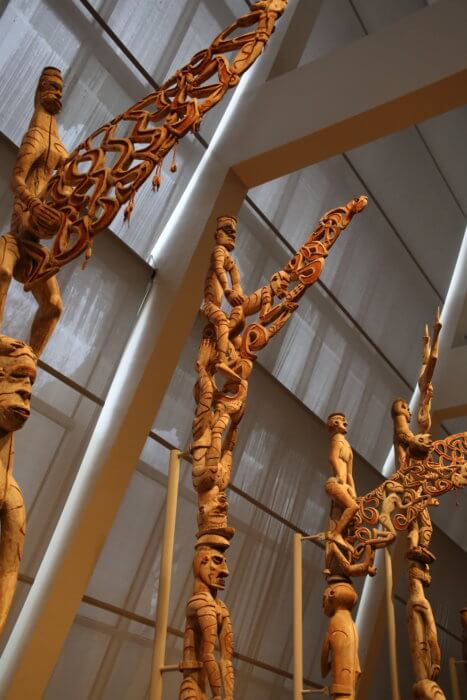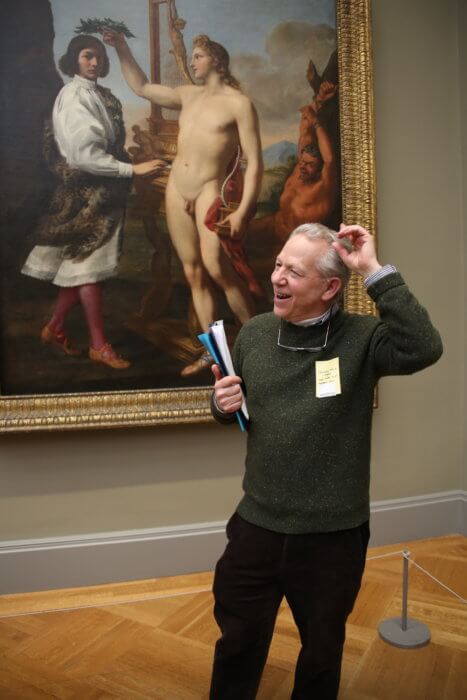Don’t say you’ve never noticed before. If you want to look at penises, few places match a museum.
That’s the premise behind the new two-hour “Unhung Heroes” tour of the Metropolitan Museum of Art, run by Professor Andrew Lear of Oscar Wilde Tours. As the name indicates, it’s not about the well-endowed but rather why so many penises in classical art — from the Ancient Greeks through the Renaissance and beyond — fail today’s Grindr expectations.
Lear is known for other unusual-themed tours of the Met, including his “Shady Ladies and Nasty Women,” examining female figures in art who are powerful and defy expectations. I have also been on his “Gay Secrets of the Met” tour. Oscar Wilde also runs tours to Italy and Greece, the original penis source — well, at least where art is concerned.
Why are museums so special?
“The Met is the encyclopedic museum,” according to Lear, and as a result, “the borderline between art and anthropology is very thin. It is so big and so diverse, it is a great place to begin to design all kinds of interesting explorations.”
Certainly, thousands of years of penises are included there. In fact, the tour was something Lear said he had long thought about.
“As I specialized in Greek art and gender and sexuality, I knew well where all the penises were” in museums, he said.
Lear started, where else, but in the ancient Greek art section on the main floor. The first object was an unusual sixth century BCE terra cotta vase shaped like a penis with holes on the edge of it, as if it might also have also been a pendant. As Lear explained, “Penises were central to ancient Greek culture, but just what it means individually is unclear. To some extent it might just be a joke.” The vase seemed to have contained an oil at one point, possibly medicinal for erectile dysfunction. Ancient Viagra if you will.
Hercules was next on the list, and this was a counterintuitive experience. For someone so virile, Lear explained, his manhood is “tiny, it’s really tiny. That is not what we would expect if we depicted Hercules. Our culture has become obsessed with whether a penis should be large, but it is so recent that idea.”
This gets to the heart of some of what Lear is trying to explain on the tour, which also takes in the portrayal of women’s breasts through the ages too, as demonstrated mostly by medieval and Renaissance art. Beyond prurient titillation, the tour offers a chance to learn about changes in thought about the human body over time, as evidenced by art.
“I think like all of my tours, there is a pretty strong implication that sexuality and gender things have varied a lot by culture. It’s not a simple or a simplistic issue, instead one that is really complex and interesting, and certainly same-sex stuff has a lot to do with that, attitudes toward same-sex things are certainly very connected, certainly to the Greek stuff,” Lear said, explaining why his tours are especially popular for those with queer sensibilities.
Lear, who has taught at Pomona College and New York University, also believes that our modern-day obsession with penis size came out of gay culture.
“There is a fixation in our culture on penis size,” he said. “In fact, we live in a world right now in which penises are either large or small, there are no normal penises. In fact, as we all know, 90 percent of penises are in a pretty normal range. But guys have become completely obsessed with penis size, and this being a recent phenomenon just interests me.”
Men are now being made to adhere to standards long projected onto women, he argued.
“It could just be the kind of attitude we have had toward women’s bodies is being applied to men’s bodies,” according to Lear. “After all, large breasts are not more attractive than small breasts or more sexually functional, but we have for a long time, in our culture, large breasts have been perceived as better.”
Consumerism, or “bigger is better,” is also a part of it, he believes.

It’s not only European art on the tour, which also includes the Oceania area boasting an exhibit of bis poles that once adorned the men’s lodges in a village in Papua New Guinea. They are not ancient, but rather from the 1960s.
“Here we are in a culture with a somewhat different view of penises,” he said, his hands pointing up into the air at the poles, some 20 feet in height, adding, “It’s from a culture in which penises occupy a pretty central location.”
It’s also clear that one depicts two men having anal sex.
“Men’s lodges are responsible for organizing initiation rites, and initiation rites in this tribe apparently involved anal intercourse and this speaks to the size of penises in New Guinea art,” Lear explained, adding that the ritual was based on the concept that “in order for boys to become men, you have to put sperm into them.”
Anal sex was one way to do so.
From there, the tour moves on to the European Renaissance, first hitting the Dutch masters, where Lear said he enjoys “pointing out sexy parts.” There paintings of tipsy wives with come-hither looks, others with Mardi Gras drag, and a variety of phallic symbols.
Also from this period is “The Judgment of Paris” (circa 1528) by the German painter Lucas Cranach the Elder. The nude goddesses Minerva, Venus, and Juno have what Lear called “armpit breasts,” based on how the clothing of the era pushed breasts up and away from the center of the chest. These were intended to be naturalistic depictions of women in the nude, but similar examples of clothed women where breasts were painted based on where the bustline was positioned abound, as well.

One of the more curious European paintings on the tour, which is also a stop on Lear’s LGBTQ Met art tour is Italian castrato “Marcantonio Pasqualini Crowned by Apollo” (1641) by Andrea Sacchi. Stepping in front of the massive exquisite painting, Lear explained the castrato concept — as few on the tour seemed to know the term — and discussed homoeroticism in depictions of Apollo. Referring to Apollo, he said, “One of the big questions about this painting is, why is that guy’s dick in the middle” of the painting?
In some ways, that too can be interpreted as a joke, or a comment on the fact that Apollo “has nuts and [Marcantonio] doesn’t.” The contrast between the castrato and the god anointing him thereby is made unmistakable.
These are just some of the highlights, with the art in Lear’s tour running the gamut of the Met’s treasures. There are of course, plenty of penises not on the tour, and I found a crowd ogling one on the giant second century BCE bronze masterpiece called simply “Bronze statue of a man.” Having come to the Met since I was a child, I was reminded it had long been among my own favorite penises in the museum — long before any formal tour meant I no longer had to surreptitiously gaze at it.

















